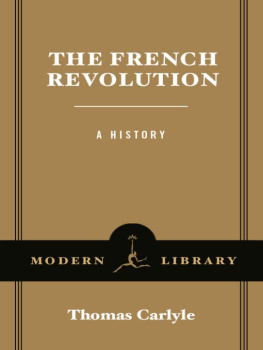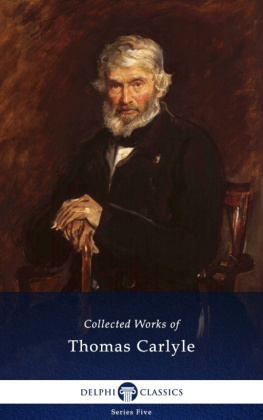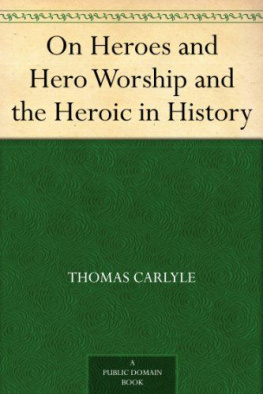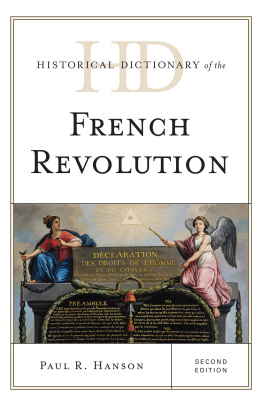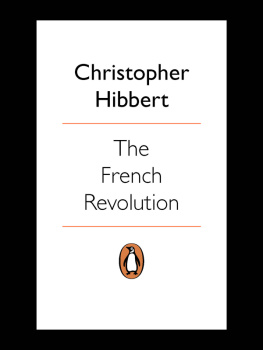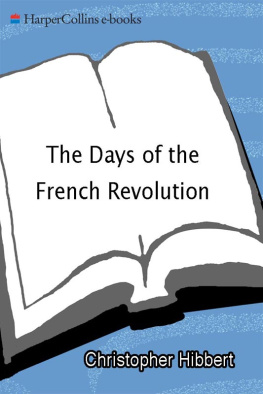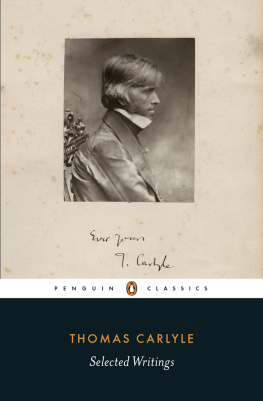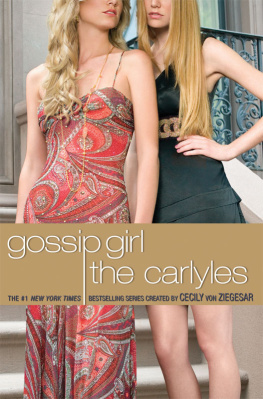Table of Contents
THOMAS CARLYLE
Thomas Carlyle was born on December 4, 1795, in Ecclefechan, Scotland, into a strict and pious Calvinist family. After attending Annan Academy (180609) and Edinburgh University (180914; he left without taking a degree), he began a career as writer and critic, initially working as a translator and reviewer. His first book began as a biographical essay commissioned by London Magazine, evolving into a full-length biography, The Life of Friedrich Schiller (1825).
Carlyle was introduced to London literary circles on a visit in 1824; he later became close friends with J. S. Mill, John Sterling, and many others. With a strong interest in German literature, biography, and history, he began contributing regularly to the Edinburgh Review and other publications. In the early 1830s, Fraziers magazine published in installments a novel, Sartor Resartus, which, while received harshly at the time, is now regarded by many as a highly innovative masterpiece. In 1834 Carlyle began work on The French Revolution, which would take him three years to complete. The story of its completion is legendary: while left in the care of J. S. Mill, Carlyles complete manuscript was mistaken for trash and burned. It was said that Carlyle then rewrote the entire manuscript from memory. The French Revolution was Carlyles first broad popular and critical success.
Carlyles literary output was prodigious, and his influence upon his contemporaries is hard to overstate; at the height of his powers he was probably the most influential literary figure in Victorian letters. Other major works include On Heroes, Hero-Worship and The Heroic in History, which originated as a series of lectures in 1840; Latter-Day Pamphlets (1850), a work highly critical of democracy, and also unsympathetically received by critics; The Life of John Sterling (1851); and the monumental History of Friedrich II of Prussia, called Frederick the Great (published in six volumes, 185865).
Speaking of his influence, George Eliot wrote, It is an idle question to ask whether his books will be read a century hence; if they were all burnt... on his funeral pile, it would be only like cutting down an oak after its acorns have sown a forest. For there is hardly a superior and active mind of this generation that has not been modified by Carlyles writing. He died on February 5, 1881, and his reputation thereafter went into a steep decline. In the years since, his writings have continued to suffer neglect, though in recent decades there have been signs of renewed interest. As one recent biographer, Simon Heffer, noted in 1992, No one from his time cries out for rediscovery and reappraisal as urgently as he does.
INTRODUCTION
John D. Rosenberg
The archetypal Victorian, Thomas Carlyle was born in the same year (1795) as the Romantic Keats. Yet in the course of his long life, England changed radically under the twin pressures of two revolutions, the French and the Industrial. The first inspired Carlyles The French Revolution (1837), the second, his great outcry against the barbarism of laissez-faire capitalism, Past and Present (1843). By the end of his long life, England had undergone a political and cultural sea change. In the year before his death in 1882, Oscar Wilde published his Poems and Gilbert and Sullivans Patience opened on the London stage. Yeats and Kipling were in print before the end of the 1880s. Long estranged from his earlier radicalism, Carlyle lived out his last solitary decade in a kind of posthumous silence, a spectre moving in a world of spectres. The world had changed; Carlyle had not.
Yet in the third quarter of the nineteenth century, Carlyle was the most widely influential voice in the English-speaking world. Those he profoundly touched constitute a roster of eminent Victorians, English and American: the young John Stuart Mill, Ruskin, Dickens, Emerson, Whitman, Melville, Tennyson, Browning, Arnold, Meredith. All in one way or another discovered themselves in discovering Carlyle. Dickens dedicated Hard Times to Carlyle, and across the channel En-gels paid him fervent tribute in a review of Past and Present. George Eliot wrote that for the leading minds of her generation the reading of Carlyle was an epoch in the history of their minds. And after the news of Carlyles death reached Whitman, he remarked that trying to imagine the larger culture of the past half-century without Carlyle would be like trying to imagine an army with the artillery left out.
Yet today, Carlyle is rarely read by nonspecialists and only occasionally appears on reading lists within the academy. The causes are many, not least of which is that Carlyle is one of the most allusive and innovative of English prose writers, a kind of proto-Joyce in his incessant verbal coinages, 1 conflation of ancient myth and modern actuality, his labyrinthine narrative strategies and gift for impersonation. It is impossible to speed-read Carlyle, any more than Milton, whose Paradise Lost figures on virtually every page of The French Revolution, as do Homer and the Bible. If he is now half-forgotten, his is not the case of a once-inflated popular reputation expiring into decent oblivion, but of meteoric genius now in partial eclipse. Nowhere is that genius on more dazzling display than in The French Revolution, at last available to American readers, complete and moderately priced, in the present Modern Library edition.
No creation of Carlyles is more striking than his self-creation as a poet-prophet in the years immediately preceding the composition of The French Revolution. In 1826, he married the brilliant Jane Baillie Welsh, who, in choosing Carlyle, made a kind of Faustian bargain, selling not her soul but her happiness by wedding genius in the person of her difficult, dyspeptic, possibly impotent, and self-absorbed husband. In 1828, they moved to virtual seclusion on a farm amidst the desolate Scottish moors at Craigenputtock. For the following six years, Carlyle searched to find his true vocation. He published anonymously a remarkable series of essays surveying the whole of contemporary English culture. Emerson read them in America, recognized a new mind of the first magnitude, and journeyed all the way to Craigenputtock to greet their author. During these years he created one of the strangest, most innovative books in English, the quasi-autobiographical Sartor Resartus (183334). In Sartor he became adept at impersonating many voices, and, most memorably, he anatomizes the revolution in individual consciousness that results in conversion, as he was soon to explore conversion writ large as revolution across the nation of France. But he had yet to find a subject large enough to contain his ambition as a writer or a style appropriate to his subject. He began to groom himself for the role of latter-day prophet, a kind of ironic John the Baptist in an age that worshipped the machine. I have some thoughts of beginning to prophecy [ sic ]... that seems the best style, could one strike into it rightly, he wrote in 1829 to the editor of Blackwoods Magazine. His new friend John Stuart Mill sent him a library of books on the French Revolution, and in a letter of 1833 acknowledging the gift, Carlyle announces that the right History of the Revolution would be the grand Poem of our Time.... [The] man who could write the truth of that, were worth all other writers and singers. The French Revolution is just that, one of the grand poems of his century, yet its poetry consists in being everywhere scrupulously rooted in historical fact. But the letter most revealing of Carlyles self-consecration as poet-prophet-historian is his first to Emerson: I am busy constantly studying with my whole might for a Book on the French Revolution. It is part of my creed that the only Poetry is History, could we tell it right. To tell it right means, first, transcending the linear, time-bound limits of narrative so that, for example, when Carlyle depicts the storming of the Bastille in a roar of voices, his reader also hears the crashing of the towers of Troy and the fall of the walls of Jericho. Narrative is linear, Action is solid, Carlyle had written in On History (1830). How then can a writer render in lines on a page a world in upheaval in which all events are contiguous with all other events, prior or contemporaneous, and events themselves are highly problematic, a world in which everything, as Carlyle delights in pointing out, is optique, depends upon the angle of vision of countless beholders? The solution is to create through a montage of words on a page a world of historical actuality in which no event occurs in isolation from any other and all are rendered in their rounded fullness.

